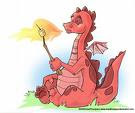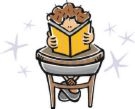Halloween, a holiday celebrated the night of October 31, is one of our oldest holidays. Its' origins can be traced back thousands of years. Many countries and cultures have influenced the day from Roman Pomona Day, one of the eight sabots or holidays celebrated by pagans, to the Celtic festival of Samhain ~ a festival marking the end of summer ~ to the Christian holidays of All Saints Day and All Souls Day.
The word itself comes from Old English for All Hallows Eve (in old English a hallow is a saint). Many of the traditions and customs of Halloween predate Christianity. November 1 symbolizes the Celtic New Year, the end of summer and beginning of winter. Evil spirits such as witches were believed to roam the Earth on this evening playing tricks and marking the beginning of the season of diminishing light. This is how the customs of disguising oneself as one of these evil spirits to avoid demonic possession for this is when the spirits are most able to make contact with the human world and magic is at its strongest according to mythology about witches and the Irish Sidhe tales. The offering of dainty foods and sweets also became tradition in an effort to divert the evil spirits attentions away from oneself. Although All Saints Day is now considered to occur one day after Halloween.
On October 31, after the crops had been harvested and stored for the long, cold, winter, the Celtic priests would meet in the hilltop of a dark oak forest (oaks were considered to be sacred). They would offer sacrifices of crops and animals as they danced around their bonfire, many wearing costumes made from skins and heads of animals, signifying the passing of the “season of the sun” and the coming of “the season of darkness and cold”. The fires were meant to keep them safe from evil spirits. In the morning the priests would give embers to each family to take home to start their cooking fire, now that they had been blessed, so the homes would also be warm and free of evil. This festival was called the Samhain.
In 835 AD the Roman Catholic Church made November 1 a church holiday to honor all the saints; it was called All Saints Day or All Hallows. Later they declared November 2 to be All souls day, a day for honoring the dead. Celebrations for these church holidays were quite similar to the Samhain, with people dressing as saints, angels and devils. The mix of these celebrations became known as all Hallows Eve, eventually shortened to Halloween.
Traditional ways of celebrating today are influenced greatly from Pomona Day with apples, nuts and harvest celebrations and the Festival of Samhain with black cats, magic, evil spirits, and ghosts, skeletons and angels from All Saints and All souls Days from the Catholic Church. Besides dressing in costume is the children’s annual “Trick or Treat” practice of going about in costume requesting treats or they will play a trick on you.
I have great memories of Halloweens past from my youth, as well as "Kodak-moment" memories from my son's youth. In our family it has always been a time of great fun and celebration. Memories of parades in costume, costume contests, trick or treating, bobbing for apples, Halloween parties, all in the spirit of great fun. I think I'll go have a caramel apple and get ready for all the trick or treaters ~~ Go make some memories and have a fun holiday, everyone!
The word itself comes from Old English for All Hallows Eve (in old English a hallow is a saint). Many of the traditions and customs of Halloween predate Christianity. November 1 symbolizes the Celtic New Year, the end of summer and beginning of winter. Evil spirits such as witches were believed to roam the Earth on this evening playing tricks and marking the beginning of the season of diminishing light. This is how the customs of disguising oneself as one of these evil spirits to avoid demonic possession for this is when the spirits are most able to make contact with the human world and magic is at its strongest according to mythology about witches and the Irish Sidhe tales. The offering of dainty foods and sweets also became tradition in an effort to divert the evil spirits attentions away from oneself. Although All Saints Day is now considered to occur one day after Halloween.
On October 31, after the crops had been harvested and stored for the long, cold, winter, the Celtic priests would meet in the hilltop of a dark oak forest (oaks were considered to be sacred). They would offer sacrifices of crops and animals as they danced around their bonfire, many wearing costumes made from skins and heads of animals, signifying the passing of the “season of the sun” and the coming of “the season of darkness and cold”. The fires were meant to keep them safe from evil spirits. In the morning the priests would give embers to each family to take home to start their cooking fire, now that they had been blessed, so the homes would also be warm and free of evil. This festival was called the Samhain.
In 835 AD the Roman Catholic Church made November 1 a church holiday to honor all the saints; it was called All Saints Day or All Hallows. Later they declared November 2 to be All souls day, a day for honoring the dead. Celebrations for these church holidays were quite similar to the Samhain, with people dressing as saints, angels and devils. The mix of these celebrations became known as all Hallows Eve, eventually shortened to Halloween.
Traditional ways of celebrating today are influenced greatly from Pomona Day with apples, nuts and harvest celebrations and the Festival of Samhain with black cats, magic, evil spirits, and ghosts, skeletons and angels from All Saints and All souls Days from the Catholic Church. Besides dressing in costume is the children’s annual “Trick or Treat” practice of going about in costume requesting treats or they will play a trick on you.
I have great memories of Halloweens past from my youth, as well as "Kodak-moment" memories from my son's youth. In our family it has always been a time of great fun and celebration. Memories of parades in costume, costume contests, trick or treating, bobbing for apples, Halloween parties, all in the spirit of great fun. I think I'll go have a caramel apple and get ready for all the trick or treaters ~~ Go make some memories and have a fun holiday, everyone!
Like this post? Tweet it! Go ahead, you know you want to!




























1 comments:
Thanks for the background info. Have a great weekend.
Stephen Tremp
Post a Comment